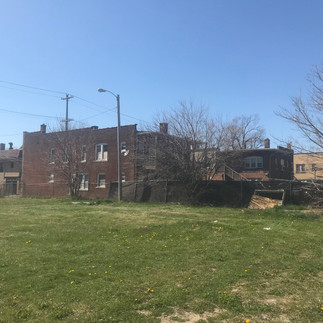
Happy October,
I am honored to be invited to Praxis by founder, Jessica Pinsky, for a reading of my book My Indigo World and tataki-zome workshop this Sunday (October 15th) in Cleveland, OH! I wanted to share more about Praxis' commitment to their community in building a an environment centered around a shared love of fiber and Sukumo indigo.
This blog was written and submitted by Jessica Pinsky.
1. Location & Environment
Praxis is located in North Collinwood, a neighborhood on the east side of Cleveland, OH in the county of Cuyahoga. The terms “Cuyahoga” and “Ohio” are both derived from languages of various Indigenous tribes that lived here for thousands of years. We recognize those people for their careful stewardship of this land and acknowledge the thousands of Native Americans who today call Northeast Ohio home.
Although most Americans own a piece of denim in their wardrobe, most don’t know its origin and connection to slavery in our country. In a neighborhood whose population is majority African American, it is important to Praxis to hold the memory of this complex history within our indigo practice. It is also important to promote a safe, socially inclusive, and equality-d
riven, farming practice for a crop that was historically discriminatory and dangerous. We make sure to explain that African indigo was majority grown in this country, we are invested in the japanese tradition here at Praxis.
2. Indigo plants & practices
Praxis Fiber Workshop connects our community to a broad picture of the contemporary and historic textile field. We share about textiles as they grow from the land all the way to the most advanced technological equipment. When it came to growing, we were complete novices. It wasn’t until meeting Rowland Ricketts in 2016, we knew we had to grow indigo! Rowland specializes in the Japanese tradition of sukumo (Polygonum tinctorium). He explained that Japanese indigo would grow best in the climate in northeast Ohio, similar to his set up in Bloomfield, Indiana. And this started our deep dive into growing and processing sukumo! In early 2018, Rowland sent us a bag of seeds harvested in 2016 which were expected to germinate around 30%. We turned to a local org, Cleveland Seed Bank for advice and assistance in starting our seeds and planning our garden. Shortly after, we met the most passionate team of landscapers who adopted us and began to prepare our VERY rough land for a giant community planting day scheduled just days ahead. Dozens of people came to help us plant seedlings that year and it sparked our joy and commitment to seeing this project through. We went to Indiana to learn how to harvest and to see the composting floor Rowland has built and we began to plan for our own facility here in Cleveland. We turned harvesting into giant community parties and shared the joy and magic of indigo with our neighborhood.
After more weeding, watering and harvesting than we ever thought possible, we had only 150 pounds of dried indigo leaves- a far cry from the necessary 400 it takes to produce sukumo. Sukumo is made by composting dried leaves and the large amount is necessary for the compost pile to reach a higher temperature. Undiscouraged, we doubled our funding and doubled our scale in year 2. This time, we involved a local K-8 school and developed a curriculum for the 4th grade where students would create an indigo themed play. With Praxis staff, the students wrote a script, created costumes and a set, all to tell the story of indigo! We were months away from our public production with the 4th graders when the pandemic started.
At this point we relied heavily on volunteers to grow the mass amount of indigo required for sukumo. We had started our seeds, and didn’t know how the project could continue. Because we were unable to gather volunteers for our 2020 growing season, we asked those volunteers to adopt indigo to grow in their home gardens. 75 people grew five indigo plants each at home and every week, Praxis released a YouTube video explaining how to care for the indigo, how to harvest it and education revolving around the dye. This project was so deeply connecting and meaningful during such an isolating time, that we continued in 2021 with an unexpected 200 people participating!! We worked with local artist and dyer Tony Williams to great programming around the weekly videos and finished season 2 with more love than ever for our community project.
It took us almost 4 years and endless labor to create our first ever fermented sukumo vat. Once the composting is complete (a 14 week process where we turn the compost pile each week) we slowly add wood ash lye to the sukumo to create the dye. Rowland came to help us build our very own composting floor - only a few of these are in the US! We partnered with our local wood fire pizza restaurant for the wood ash and slowly made 5 strengths of lye for the vat. We now have a composting floor and continuous vat alive and available for use at Praxis. But, what now? We have been rebuilding our community post pandemic and our collective needs are always changing and evolving. In order to create a program with the needs of the community in mind, we have launched an indigo cooperative. So far, we have 11 members who are meeting monthly to care for, use, create and learn around the Praxis indigo program. We are building a curriculum and ultimately hiring community members to help us expand our dye production. Indigo is truly a collective effort and we have learned so much from this amazing plant.
3. Culture & Story of the region
North Collinwood is a unique district on Cleveland’s east side. Collinwood grew around the rail yards of the Lake Shore and Michigan Southern Railway and is divided by these same tracks into the neighborhoods of North and South Collinwood. During the train yard’s most popular days, the close corridor of Waterloo Road was a bustling commercial district. When the train yard closed in 1981 it left over 2,000 Collinwood residents jobless. The economy of the neighborhood has shifted and changed since then, leaving a partially restored, partially sunken community. With assets such as highway access and lakefront property, Collinwood remains a hidden gem in Cleveland. It draws attention from an artistic community attracted to the possibilities of a neighborhood with relatively low real estate value and multitude of vacancies.
When searching Cleveland for the exact location of Praxis in 2012, we fell in love with North Collinwood. We love that this corridor sits within a deeply rooted residential community and hosts foot traffic from many visitors throughout the week. An organization has a responsibility to its neighbors; to provide opportunities to learn and connect. We do this in many ways, but our natural dye initiative is our most mature program. Since 2018, we have grown around 4000 indigo plants per year on two vacant parcels in the residential area of the neighborhood. We lease this land from the city land bank and have made deep connections with the surrounding neighbors since cultivating indigo on this land for the past 5 years. In 2019, we doubled our scale with a second lot which ultimately is located on the vacant parcel next to our Digital Weaving Lab. We are so happy to now have indigo growing on site at the Praxis campus.
3. Mission and Vision
Praxis Fiber Workshop builds the international network of fiber artists and makers through classes, workshops, residencies, and collaborative projects that teach the art form and demonstrate how fiber art can be used to build healthy, resilient, and inclusive communities.
Praxis Fiber Workshop was established in January 2015. In collaboration with Cleveland Institute of Art, Praxis leased the equipment that previously belonged to the Fiber Arts Department and opened as a community arts space in the Waterloo Arts District of Cleveland. The organization is described as a gem among Northeast Ohio’s diverse network of small arts organizations. At the same time, in our short life, we have achieved recognition in national and international circles.
1▪ Service to fiber artists and makers. Praxis offers classes, studio space and exhibition space (for credit to CIA students) to a growing local community, and partners with local schools to reach underserved youth.
2.Neighborhood sustainability. In 2018, Praxis launched a Natural Dye Initiative, growing half an acre of natural indigo in its neighborhood and distributed indigo growing to community members throughout Northeast Ohio.
3▪ Digital Weaving Lab. The Digital Weaving Lab offers boundary-pushing technological weaving equipment to artists from all over the world and includes an apartment for artist residents.
Connect
Praxis Studio: praxisfiberworkshop.org
Contact Praxis' Team: contact@praxisfiberworkshop.org
Follow on Instagram: @praxisfiberworkshop





























Comments